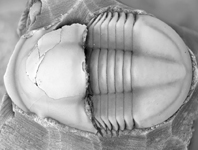Abstract
The Cambrian (Marjuman–Steptoean; Guzhangian–Paibian) kingstoniid trilobite Blountia Walcott, 1916 is distributed widely in shelf strata of Laurentian North America. Species known from Marjuman formations were lost at the mass extinction at the end of that stage. New species entered the succession during and after the extinction interval, only to disappear within the Aphelaspis Zone of the lower part of the Steptoean Stage. Steptoean species and several uppermost Marjuman (Crepicephalus Zone) species are treated in this monograph. New collections and revision of type and other archival material increase the number of species in Steptoean strata from two to six. Phylogenetic analysis supports monophyly of Blountia and Maryvillia Walcott, 1916; Blountina Lochman, in Lochman & Duncan, 1944 is retained as a monotypic taxon. Steptoean species do not form a single subclade within the cladogram, so there is no evidence for a simple monophyletic radiation following the end-Marjuman extinction. New species are Blountia angelae, B. morgancreekensis, B. nevadensis, B. newfoundlandensis, and B. tennesseensis.
References
Armstrong, M. (2018) Trilobites from a Cambrian extinction interval at the base of the Steptoean Stage, Riley Formation, central Texas. M.S. Thesis, University of Oklahoma, Norman, 266 pp.
Bernstein, L., James, N.P. & Lavoie, D. (1992) Cambro-Ordovician stratigraphy in the Québec Reentrant, Grosses-Roches—Les Méchins area, Gaspésie, Québec. Current Research Geological Survey of Canada, 92-1E, 381–392.
https://doi.org/10.4095/133593
Carlson, M.P. (1999) Transcontinental Arch—A pattern formed by rejuvenation of local features across central North America. Tectonophysics, 305, 225–233.
https://doi.org/10.1016/S0040-1951(99)00005-0
Goloboff, P.A., Farris, J.S. & Nixon, K.C. (2008) TNT, a free program for phylogenetic analysis. Cladistics, 24, 774–786.
https://doi.org/10.1111/j.1096-0031.2008.00217.x
Jablonski, D. (2002) Survival without recovery after mass extinctions. Proceedings of the National Academy of Sciences, 99, 8139–8144.
https://doi.org/10.1073/pnas.102163299
Lochman, C. (1938) Upper Cambrian faunas of the Cap Mountain Formation of Texas. Journal of Paleontology, 12, 72–85.
Lochman, C. & Duncan, D. (1944) Early Upper Cambrian faunas of Central Montana. Geological Society of America Special Papers, 54, 1–172.
https://doi.org/10.1130/SPE54-p1
Nixon, K.C. (2002) WinClada. Version 1.00.08. Published by the author, Ithaca, New York.
Palmer, A.R. (1954) The faunas of the Riley Formation in central Texas. Journal of Paleontology, 28, 709–786.
Palmer, A.R. (1962) Glyptagnostus and associated trilobites in the United States. U.S. Geological Survey Professional Paper, 374F, 1–49.
https://doi.org/10.3133/pp374F
Palmer, A.R. (1965) Trilobites of the Late Cambrian Pterocephaliid Biomere in the Great Basin, United States. U.S. Geological Survey Professional Paper, 463, 1–105.
Pratt, B.R. (1992) Trilobites of the Marjuman and Steptoean stages (Upper Cambrian), Rabbitkettle Formation, southern Mackenzie Mountains, northwest Canada. Palaeontographica Canadiana, 9, 1–179
Rasetti, F. (1946) Early Upper Cambrian trilobites from western Gaspé. Journal of Paleontology, 20, 442–446.
Rasetti, F. (1956) Revision of the trilobite genus Maryvillia Walcott. Journal of Paleontology, 30, 1266–1269.
Rasetti, F. (1961) Dresbachian and Franconian trilobites of the Conococheague and Frederick limestones of the central Appalachians. Journal of Paleontology, 35, 104–124.
Rasetti, F. (1965) Upper Cambrian trilobite faunas of Northeastern Tennessee. Smithsonian Miscellaneous Collections, 148, 1–127.
Resser, C.E. (1938) The Cambrian (Restricted) of the southern Appalachians. Geological Society of America Special Papers, 15, 1–140.
Resser, C.E. (1942a) Fifth contribution to nomenclature of Cambrian fossils. Smithsonian Miscellaneous Collections, 101, 1–58.
Resser, C.E. (1942b) New Upper Cambrian trilobites. Smithsonian Miscellaneous Collections, 103, 1–136.
Shaw, A.B. (1952) Paleontology of Northwestern Vermont: II. Fauna of the Upper Cambrian Rockledge Conglomerate near St. Albans. Journal of Paleontology, 26, 458–483.
Stitt, J.H. & Perfetta, P.J. (2000) Trilobites, biostratigraphy, and lithostratigraphy of the Crepicephalus and Aphelaspis zones, lower Deadwood Formation (Marjuman and Steptoean stages, Upper Cambrian), Black Hills, South Dakota. Journal of Paleontology, 74, 199–223.
https://doi.org/10.1017/S0022336000031437
Swofford, D. (2003) PAUP*: Phylogenetic Analysis Using Parsimony (* and Other Methods) Version 4. Sinauer Associates, Sunderland, Massachusetts. [program]
Walcott, C.D. (1916) Cambrian Geology and Paleontology III. Smithsonian Miscellaneous Collections, 64, 1–234.
Walcott, C.D. (1889) Chapter 12. Paleozoic fossils. Section I.—Cambrian fossils. In: Hauge, A., Iddings, J.P., Weed, W.H., Walcott, C.D., Girty, G.H., Stanton, T.W. & Knowlton, F.H. (Eds.), Geology of Yellowstone National Park. Part II. Descriptive Geology, Petrography, and Paleontology. U.S. Geological Survey Monograph, 32, pp. 440–478.
Walcott, C.D. (1916) Cambrian Geology and Paleontology III. No 5. Cambrian trilobites Smithsonian Miscellaneous Collections, 64 (5), 303–457.
Westrop, S.R. (1992) Upper Cambrian (Marjuman-Steptoean) trilobites from the Port au Port Group, western Newfoundland. Journal of Paleontology, 66, 228–225.
https://doi.org/10.1017/S0022336000033758
Westrop, S.R. & Adrain, J.M. (2007) Bartonaspis new genus, a trilobite species complex from the base of the Upper Cambrian Sunwaptan Stage in North America. Canadian Journal of Earth Sciences, 44, 987–1003.
https://doi.org/10.1139/e07-009
Westrop, S.R. & Eoff, J.D. (2012) Late Cambrian (Furongian; Paibian, Steptoean) agnostoid arthropods from the Cow Head Group, Western Newfoundland. Journal of Paleontology, 86, 201–237.
https://doi.org/10.1666/11-034.1
Westrop, S.R. & Dengler, A.A. (2014) The mid Cambrian (Guzhangian; Marjuman) trilobite genus Catillicephala Raymond 1938 (Catillicephalidae) from the Cow Head Group and correlatives in eastern Canada. Memoirs of the Association of Australasian Palaeontologists, 45, 89–116.
Westrop, S.R., Landing, E. & Dengler, A.A. (2018) Pseudocryptic species of the Middle Cambrian trilobite Eodiscus Hartt, in Walcott, 1884, from Avalonian and Laurentian Newfoundland. Canadian Journal of Earth Sciences, 55, 997–1019.
https://doi.org/10.1139/cjes-2018-0027
Wilkinson, M. (1995) Coping with abundant missing entries in phylogenetic inference using parsimony. Systematic Biology, 44, 501–514.
https://doi.org/10.1093/sysbio/44.4.501
Wilkinson, M. (2003) Missing entries and multiple trees: instability, relationships, and support in parsimony analysis. Journal of Vertebrate Paleontology, 23, 311–323.
https://doi.org/10.1671/0272-4634(2003)023[0311:MEAMTI]2.0.CO;2


